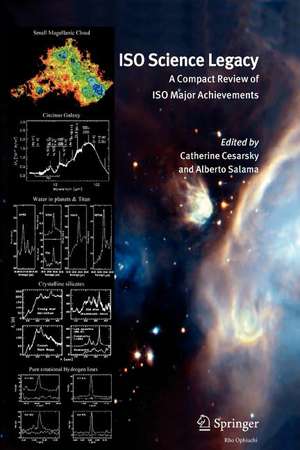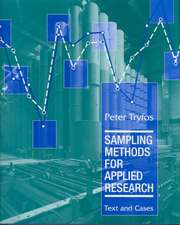ISO Science Legacy: A Compact Review of ISO Major Achievements
Editat de Catherine Cesarsky, Alberto Salamaen Limba Engleză Paperback – 19 oct 2010
Outstanding results have been obtained on the bright comet Hale-Bopp, and in particular of its water spectrum, as well as on the formation, chemistry and dynamics of planetary objects in the solar system. Ideas on the early stages of stellar formation and on the stellar initial mass function have been clarified.
| Toate formatele și edițiile | Preț | Express |
|---|---|---|
| Paperback (1) | 952.09 lei 6-8 săpt. | |
| SPRINGER NETHERLANDS – 19 oct 2010 | 952.09 lei 6-8 săpt. | |
| Hardback (1) | 963.15 lei 6-8 săpt. | |
| SPRINGER NETHERLANDS – 17 ian 2006 | 963.15 lei 6-8 săpt. |
Preț: 952.09 lei
Preț vechi: 1161.08 lei
-18% Nou
Puncte Express: 1428
Preț estimativ în valută:
182.24€ • 198.02$ • 153.18£
182.24€ • 198.02$ • 153.18£
Carte tipărită la comandă
Livrare economică 22 aprilie-06 mai
Preluare comenzi: 021 569.72.76
Specificații
ISBN-13: 9789048169795
ISBN-10: 9048169798
Pagini: 456
Ilustrații: VIII, 446 p.
Dimensiuni: 160 x 240 x 24 mm
Greutate: 0.64 kg
Ediția:Softcover reprint of hardcover 1st ed. 2005
Editura: SPRINGER NETHERLANDS
Colecția Springer
Locul publicării:Dordrecht, Netherlands
ISBN-10: 9048169798
Pagini: 456
Ilustrații: VIII, 446 p.
Dimensiuni: 160 x 240 x 24 mm
Greutate: 0.64 kg
Ediția:Softcover reprint of hardcover 1st ed. 2005
Editura: SPRINGER NETHERLANDS
Colecția Springer
Locul publicării:Dordrecht, Netherlands
Public țintă
ResearchCuprins
General.- Crystalline Silicates.- Water in Space: The Water World of ISO.- Molecular Hydrogen.- Understanding Galaxy Formation with ISO Deep Surveys.- Solar System.- The Planets and Titan Observed by ISO.- Comets, Asteroids and Zodiacal Light as Seen by Iso.- Stars and Circumstellar Matter.- ISO Observations of Pre-Stellar Cores and Young Stellar Objects.- Pre-Main Sequence Stars Seen by ISO.- Debris Discs Around Stars: The 2004 ISO Legacy.- Late Stages of Stellar Evolution.- Interstellar Medium.- The Cool Interstellar Medium.- High Excitation ISM and Gas.- The Ice Survey Opportunity of ISO.- Our Local Universe . . ..- Normal Nearby Galaxies.- Obscured Activity: AGN, Quasars, Starbursts and ULIGs Observed by the Infrared Space Observatory.- . . . And Beyond.- The European Large Area ISO Survey.- ISO’s Contribution to the Study of Clusters of Galaxies.
Textul de pe ultima copertă
Stars are born and die in clouds of gas and dust, opaque to most types of radiation, but transparent in the infrared. Requiring complex detectors, space missions and cooled telescopes, infrared astronomy is the last branch of this discipline to come of age. After a very successful sky survey performed in the eighties by the IRAS satellite, the Infrared Space Observatory, in the nineties, brought spectacular advances in the understanding of the processes giving rise to powerful infrared emission by a great variety of celestial sources.
Outstanding results have been obtained on the bright comet Hale-Bopp, and in particular of its water spectrum, as well as on the formation, chemistry and dynamics of planetary objects in the solar system. Ideas on the early stages of stellar formation and on the stellar initial mass function have been clarified.
ISO is the first facility in space able to provide a systematic diagnosis of the physical phenomena and the chemistry in the close environment of pre-main sequence stars, in the interstellar medium, and in the final stages of stellar life, using, among other indicators, molecular hydrogen, ubiquitous crystalline silicates, water and ices.
ISO has dramatically increased our ability to investigate the power production, excitation and fuelling mechanism of galaxies of every type, and has discovered a new very cold dust component in galaxies.
ISO has demonstrated that luminous infrared galaxies were brighter and much more numerous in the past, and that they played a dominant role in shaping present day galaxies and in producing the cosmic infrared background.
Outstanding results have been obtained on the bright comet Hale-Bopp, and in particular of its water spectrum, as well as on the formation, chemistry and dynamics of planetary objects in the solar system. Ideas on the early stages of stellar formation and on the stellar initial mass function have been clarified.
ISO is the first facility in space able to provide a systematic diagnosis of the physical phenomena and the chemistry in the close environment of pre-main sequence stars, in the interstellar medium, and in the final stages of stellar life, using, among other indicators, molecular hydrogen, ubiquitous crystalline silicates, water and ices.
ISO has dramatically increased our ability to investigate the power production, excitation and fuelling mechanism of galaxies of every type, and has discovered a new very cold dust component in galaxies.
ISO has demonstrated that luminous infrared galaxies were brighter and much more numerous in the past, and that they played a dominant role in shaping present day galaxies and in producing the cosmic infrared background.
Caracteristici
A compendium of the results of the very successful Infrared Space Observatory A very readable account of the main progresses in Infrared astronomy prior to the Spitzer probe












